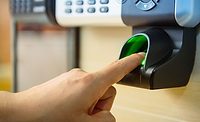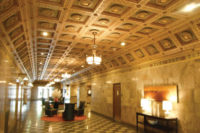Electronic Access Control Tailors Security Protocols, Boosts User-Friendliness
Facilities of all stripes, ranging from churches and school districts, to healthcare centers to manufacturing plants, continue to move from hard keys to electronic access, or to upgrade their existing electronic access systems.

The North American Stamping Group plant in Woodstock, Ontario, recently has joined its sister facilities in Mexico, Ohio, Indiana and Tennessee in moving to a Suprema Bioreader electronic access system for its 44 entrances in and around the facility, says James LeRoy, information technology systems analyst. Photo courtesy of James LeRoy
Along with the holy grail of tighter overall security, the benefits of electronic access control systems include a better handle on who’s coming and going, the ability to restrict access to certain times and places depending on a person’s function in the organization, the ability to remotely control access, the extra assurance a company or organization can give its customers, and the lack of need for rekeying doors or replacing lost keys.
For example, First Baptist Colleyville church in the Dallas-Fort Worth area decided to go with electronic access on its newly constructed children’s facility and to retrofit at least six of its seven existing buildings, starting with the worship building that adjoins the new child-care center, says Jonathan Crispin, director of campus operations for the 22-acre, 130,000-square-foot campus.
Crispin had rekeyed the entire campus shortly after arriving five years ago when he saw a van full of men drive up to one of the church’s building, pull out keys and walk in – and then leave quickly and drive off when they saw him approaching. “That led me to believe they were not supposed to be there,” he says. “Nobody recognized them, but they had a key, and they walked in and could do whatever they wanted.”
There was not a similarly suspicious incident that led to the move toward electronic key-card access, which First Baptist has purchased from Access Specialties, and to date has installed on 24 exterior and 14 interior doors on the worship center and children’s facility. The church plans to roll out the system to its remaining buildings during the next year, with the possible exception of a maintenance building, Crispin says.
“Most of the reason for that was just for overall control and security,” he says. “We don’t have to hand out as many hard-copy keys, and we can control when they get access and when they don’t, depending on whether they’re a [church] staff member, or a child-care worker, so we don’t have people coming and going at will.”
When the church hosts events, Crispin’s crew can grant access at specific times in specific locations and keep tabs through an electronic camera system to ensure that if someone says they need access, they are who they claim to be.
“I can give a card to anybody, and say, ‘OK, you have access this day, and this day, and then your card is no good after that,’ if a vendor is allowed to go into a certain area,” he says. He usually asks that people put down a deposit of $10, or leave their driver’s license, to help ensure that the cards are returned in such cases.
In the children’s building, the key-cards allow access to the lobby and then potentially to one or more of the building’s three sections, Crispin says. During drop-off and pick-up times, exterior doors are unlocked but during the day, access is through the front lobby only.
“It’s given us an added security reassurance for the parents,” he says. “They realize we are trying to protect their kids. At first some parents were standoffish – they said, ‘Wait a minute, my kid is locked behind that door, and I can’t get to him?’ But those concerns have eased. It’s an unfortunate time we live in, but we want to do our due diligence,” he adds. “If something were to arise, we could say we planned for it.”
Cancer Center Goes to Access Control
New England Cancer Specialists has put in electronic access control in three of its four locations in the state of Maine during the past couple of years, says Timothy Thornton, director of facilities management.
The center’s main site in Scarborough is contained within a hospital-owned building that already had an electronic key-pad set-up for outside doors, as well as the cancer center’s office doors. At the Brunswick location, where the cancer center rents space for a medical building, the exterior doors were handled by the building, but New England put electronic key-card access on a back interior door.
Then the center has a stand-alone medical office in Kennebunk and a business office in Scarborough where it also added electronic access control, also using key-cards in those cases, Thornton says. New England might switch to cards for the main site “but it’s working for now, so I think we will leave it as is” in that location, he says. “Directors and other managers have access to every building. It’s worked a lot better than worrying about keys for everyone.”
Thornton appreciates the ability to set up different levels of access on different cards depending upon a person’s function. “Some employees are primarily in specific offices, and some go between offices,” he says. “We have the ability to make updates and changes through an online portal. If I want to change someone’s access, or if we let an employee go and don’t get their card back for some reason, I can just turn it off. If someone is transferring to a different office and you need to change their access, it’s easy to go into the system and do it.”
The key-cards and access pads also keep records of who comes and goes when, Thornton says, so that if an alarm gets set off at 1 a.m. he knows that a certain courier was at the building – as opposed to someone attempting a break-in.
“I can call him and ask, ‘Why are you coming at 1 a.m. to pick up stuff?’ ” he says. “We know when the cleaners are in the building. If anything happened to get stolen, and someone happened to come in on the weekend, you can run reports.” If an employee forgets their code and sets off the alarm, Thornton can remind everyone how to input the code, he adds.
When the cancer center had an offsite all-staff meeting and wanted to lock the doors at 3 o’clock instead of the usual 5, Thorton could go into the system and do so. “It’s nice to be able to access and make those changes from pretty much wherever you are,” through the online portal, he says. “The other really nice feature is that it all ties into each location. We don’t have to do three different cards.”
Stamping Plant Goes Biometric
The North American Stamping Group plant in Woodstock, Ontario, recently has joined its sister facilities in Mexico, Ohio, Indiana and Tennessee in moving to a Suprema Bioreader electronic access system for its 44 entrances in and around the facility, says James LeRoy, information technology systems analyst.
The Woodstock location had been a smaller facility but has expanded three times, and the plant had reached the point where visual monitoring was increasingly difficult, which already had prompted the company to install security cameras in entrances, aisleways and at the shipping dock. The electronic access system came about due to a corporate directive, but LeRoy sounds happy to have it in place.
“We’re of the size now that we want to make sure that even if and when our customers come in to do a plant tour, they know the plans, drawings, stampings, parts and any of that is secure,” he says. “It’s helped us because you can never lose a key now. You never have anybody say, ‘I can’t do my job because I can’t get access to a certain area.’ ”
LeRoy prescreens employees and determines where they should be authorized to do, and during what time periods, and those attributes can be programmed into biometric system. “You’re authorized for this [area], and this [area],” he says. “Or you’re authorized for certain days and certain shifts – you’re able to be there from 8 to 5. If they’re there at any other time, it will deny them access. Those were the main features, to make sure people weren’t wandering into areas they weren’t supposed to be in.”
Previously the plant’s keys had operated in similar fashion in terms of parceling out access, LeRoy says, but it was considerably more difficult to change on the fly, which is why employees sometimes complained that they couldn’t get access to the right areas to do their job. “It could be a waste of time or even a waste of a whole shift because they didn’t have access to a certain door. The biometric system mitigates that.”
One challenge with the biometric system has been that some workers’ fingerprints do not scan well, particularly those with skin conditions like eczema, so LeRoy has needed to provide them with access cards on lanyards. “We’re in a factory,” he says. “Guys who have been around for awhile, their fingers don’t read very well.”
School District Going Keyless
The Hamilton School District in Hamilton, Montana, has been gradually converting from keyed doors to a browser-based access control management system at its four school buildings and administrative offices during the past two years.
The system from 3xLOGIC, Inc., has been installed at about 35 exterior doors and 250 interior doors, says Judy Hake, maintenance and transportation director, who adds that it works in tandem with the district’s “60-some” cameras.
“That has helped us get rid of keys more and more,” she says. “It’s about the accountability of the building – being able to lock the building down – and along with that, the need to get rid of manual keys so you don’t have to re-key every time somebody loses a key.”
Hamilton School District has the same security needs and concerns of school districts everywhere in trying to protect students and staff, Hake says. “It’s the general concern of how do we keep our kids safer during the day when they’re here,” she says. “It’s any scenario you can think of – active shooter is one of them. ...
“But in terms of accountability, if we have somebody break into the building, we have cameras that can spot them,” she says. “If somebody’s key is missing, and it gets picked up by somebody else, we can see where did that key go to. If something is missing in an area, there’s a theft, we can find out who went into those doors.”
The system was not designed to stop any one particular challenge, Hake says. “It covers all different layers of security,” she says. “It was the overall safety and accountability of, if a key gets lost, where does it end up?” With physical keys, “if somebody comes up with a key for the inside doors – we have events in our building all the time – they can get in,” she adds. “Plus, it’s so easy to reissue a card, as opposed to re-coring and re-cutting new keys.”
Looking for a reprint of this article?
From high-res PDFs to custom plaques, order your copy today!





